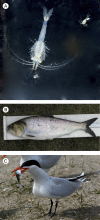Developing a broader scientific foundation for river restoration: Columbia River food webs
- PMID: 23197837
- PMCID: PMC3535603
- DOI: 10.1073/pnas.1213408109
Developing a broader scientific foundation for river restoration: Columbia River food webs
Abstract
Well-functioning food webs are fundamental for sustaining rivers as ecosystems and maintaining associated aquatic and terrestrial communities. The current emphasis on restoring habitat structure--without explicitly considering food webs--has been less successful than hoped in terms of enhancing the status of targeted species and often overlooks important constraints on ecologically effective restoration. We identify three priority food web-related issues that potentially impede successful river restoration: uncertainty about habitat carrying capacity, proliferation of chemicals and contaminants, and emergence of hybrid food webs containing a mixture of native and invasive species. Additionally, there is the need to place these food web considerations in a broad temporal and spatial framework by understanding the consequences of altered nutrient, organic matter (energy), water, and thermal sources and flows, reconnecting critical habitats and their food webs, and restoring for changing environments. As an illustration, we discuss how the Columbia River Basin, site of one of the largest aquatic/riparian restoration programs in the United States, would benefit from implementing a food web perspective. A food web perspective for the Columbia River would complement ongoing approaches and enhance the ability to meet the vision and legal obligations of the US Endangered Species Act, the Northwest Power Act (Fish and Wildlife Program), and federal treaties with Northwest Indian Tribes while meeting fundamental needs for improved river management.
Conflict of interest statement
The authors declare no conflict of interest.
Figures



References
-
- Bernhardt ES, et al. Ecology. Synthesizing U.S. river restoration efforts. Science. 2005;308(5722):636–637. - PubMed
-
- Palmer MA, et al. Standards for ecologically successful river restoration. J Appl Ecol. 2005;42:208–217.
-
- Palmer MA, Filoso S. Restoration of ecosystem services for environmental markets. Science. 2009;325(5940):575–576. - PubMed
-
- Palmer MA. Beyond infrastructure. Nature. 2010;467:534–535. - PubMed
-
- Humphries P, Winemiller KO. Historical impacts on river fauna, shifting baselines, and challenges for restoration. Bioscience. 2009;59:673–684.
Publication types
MeSH terms
LinkOut - more resources
Full Text Sources
Research Materials

